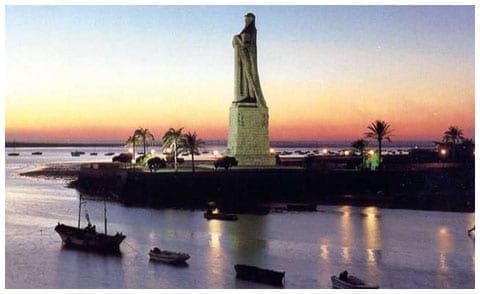
Mining centres, chemical industries, famous ham and wines are the main features of Huelva, a city of pilgrims whose past configured the first western urban civilisation exposed to the Atlantic.
History
Its situation on the Atlantic coast,
its mild climate (relatively humid), its unique rich mining deposits and its advantages for settlers all explain why, centuries ago, Huelva attracted a considerable wave of migrants, whose traces still remain to this day. In the city, and above all in the province, one is struck by the legacy of the ancient peoples of the eastern Mediterranean – the Phoenicians and the Tartessians – whose royalty settled here. At later dates Roman, Visigoth and Arab royals came to stay – the presence of the last of these remains in the form of many monuments. Finally, Huelva has a lot to do with the discovery of America. The voyage that was to change the course of history originated in La Rábida and set sail from Palos de la Frontera.
What to see:
Visitors to Huelva, especially in spring and summer, are struck by the clear light as they contemplate the Baroque cathedral built by the Duke of Medina Sidonia and the San Francisco and Concepción churches. Before pausing in the monumental San Pedro Square go up to the top of the Conquero then go down to the Paseo de los Pinzones that ends in the Punta de Sebo, erected in honour of Columbus.
The province of Huelva is rich in architectural gems, both on high ground, where there is a line of defensive castles, the majority built in the thirteenth century due to lack of trust in the kingdom of Portugal, and in the south, running from El Condado to the “Castilla beach” on the Atlantic. Here one can also admire the Niebla ramparts and the Guzmanes Castle. For those who prefer monasteries, in the Palos area lies La Rábida, the small Franciscan monastery closely linked to Christopher Columbus and the journey that began the discovery of America. Near the city, three villages evoking days gone by can be found: San Juan del Puerto, Gibraleón and Trigueros. In the municipal area of Trigueros lies the El Soto dolmen. On both sides of the river estuary are the two tourist areas of the province, Mazagón and Punta Umbría, which are outstanding for their bright beaches. A little further away you can find Ajarque and Cartaya, with their extensive areas of pine trees that meet the sea at a small fishing village, El Rompido. Fishing is also the economic means of Isla Cristina, not far from Ayamonte, which lies at the mouth of the River Guardiana on the Portuguese border. Behind this is the village of Lepe, famous for its figs and strawberries.
To the east of the province lies Moguer, with churches such as Nuestra Señora de Granada, convents such as Santa Clara and its Town Hall: all architectural elements that will surprise visitors. The Sacro Art Museum and the Juan Ramón Jiménez Museum, in memory of the poet, both offer special interest. Following the Seville road, the tourist arrives at El Condado, famous for its wine. To the north the Sierra de Aracena houses the Gruta de las Maravillas, a cave with almost 1,500 metres of maze-like galleries. With its cold dry air, this is also the area of the best cured hams in the country, although the area is also rich in churches, medieval mosques and monasteries
Festivities
One of the most famous of Spain’s traditions is the custom of the “romería”, a religious pilgrimage with a party atmosphere. The most famous of these is the “Romería del Rocío” that culminates in the shrine of Our Lady of the Rocío in the village of Almonte, located in the triangle formed by the province with Seville and the sea. Every year, one weekend in May or June, depending on the liturgical calendar, the road to the shrine becomes packed with decorated carriages and horses that move to the sound of flutes and drums and form a stampeed that never fails to be spectacular and colourful. The “Rocío” is something that has to be lived because the imagination, however vivid, is incapable of capturing the reality of this event, above all the night procession, in which the faithful cram together by torchlight in order to touch the venerated image of the Virgin of the Rocío. One would say that it is a magical night on which the whole of Andalucía catches its breath.
The experience….
Huelva’s beaches are beautifully wide, clean and uncrowded although they do have the disadvantage of being exposed to the breezes.
Despite the obvious tourist attractions of the Baroque cathedral and the Christopher Columbus monument illustrating the important history of the city, Huelva is one of the least visited Andalusian cities. This gives it an unspoilt feeling of authenticity and foreign tourists often experience the sensation of being a surprising novelty for the local “onubenses”(Huelva was originally called Onuba). An interesting feature of the city is the “Barrio Inglés”, one solitary row of English style houses in the midst of high blocks.
When shopping in Huelva and its province a must is a piece of the pottery from Trigueros or Aracena or a hand-embroidered tablecloth from Cortegena. As far as local gastronomy is concerned, the cold meats, cured hams and clear El Condado wine that can be tried in one of the many local restaurants are a pleasure to the palate. The “aguja palá” (sword fish) and the “chocos con habas” (cuttlefish with broad beans) are specialities in the small fishing villages. Strawberries from Palos and marzipan from Gibreón are recommended for dessert with a glass of golden Moguer Moscatel.
How to get there
Huelva has good train links with with all the main cities in Spain. By road, the N-341 joins Ayamonte with Seville.
When to go:
Any time, however the best months to visit Huelva are without a doubt May and June.

Be the first to comment